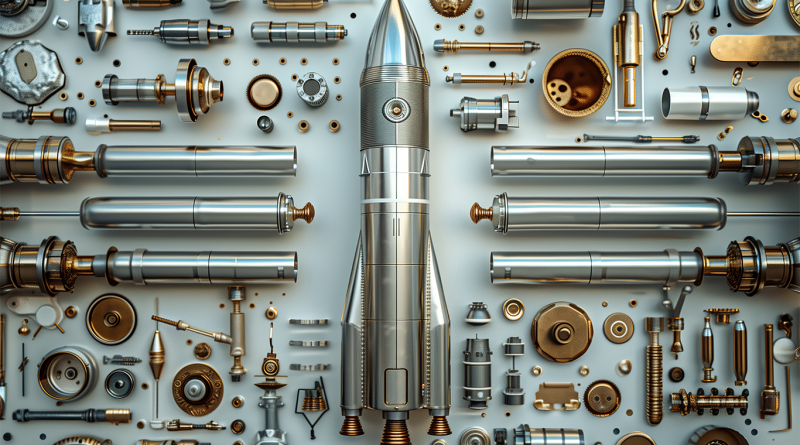The High-Tech Factory Building Rocket Parts 10 Times Faster
In a nondescript warehouse in Los Angeles, a quiet revolution is taking place that could redefine how critical components for rockets and fighter jets are made. At the heart of this transformation is Hadrian, a high-tech factory that is combining advanced automation, artificial intelligence (AI), and robotics to create precision parts up to ten times faster than traditional methods. Led by CEO Chris Power, Hadrian is poised to become a key player in the aerospace and defense sectors, offering a glimpse into the future of manufacturing — one that is more efficient, cost-effective, and agile.
Hadrian’s innovations come at a critical time for industries that demand exceptional speed and precision. The company’s approach promises to reshape the manufacturing landscape by shortening production cycles, reducing costs, and minimizing human error, all while meeting the stringent quality standards required by aerospace clients. As the global demand for defense and aerospace capabilities grows, Hadrian’s technology could be the catalyst for a new era of industrial automation.
Revolutionizing Production: How Hadrian’s Technology Works
At the core of Hadrian’s operations is a sophisticated blend of robotics, AI, and real-time data analysis, designed to automate processes traditionally dependent on human labor. Unlike conventional factories, where skilled machinists manually operate tools to produce parts, Hadrian uses a suite of advanced technologies to accelerate every aspect of production. This includes robotic arms that handle materials, AI algorithms that optimize the machining process, and sensors that provide real-time feedback to ensure precision at every step.
The factory’s software integrates seamlessly with its hardware, allowing machines to communicate with one another and adjust parameters autonomously based on real-time data. For example, if a robotic arm senses a slight deviation in the material’s alignment, it automatically corrects the position without halting production. This level of automation not only reduces human error but also significantly speeds up the production process.
Additionally, Hadrian’s approach leverages machine learning to refine and optimize production techniques continually. By analyzing data from every batch, the system becomes more efficient over time, further reducing costs and accelerating turnaround times. The result is a factory that can produce complex aerospace components, such as rocket engine nozzles or fuselage sections, in a fraction of the time it would take a traditional plant.
Impact on the Aerospace and Defense Industries
Hadrian’s innovations have the potential to significantly impact the aerospace and defense industries by addressing some of their most pressing challenges: long lead times, high production costs, and the need for extreme precision. By automating key aspects of the manufacturing process, Hadrian offers a faster, more reliable supply of components — a critical advantage for aerospace companies facing tight production schedules and stringent quality demands.
For example, major aerospace firms, such as SpaceX and Lockheed Martin, are constantly seeking ways to shorten their supply chains and reduce dependency on external suppliers. Hadrian’s model provides an in-house solution that can deliver precision parts quickly and at a lower cost. This capability is especially valuable in the defense sector, where the ability to rapidly scale up production in response to geopolitical events can be a decisive factor.
Furthermore, Hadrian’s streamlined production process helps mitigate some of the common bottlenecks associated with aerospace manufacturing, such as the limited availability of skilled machinists and the high costs of raw materials. By reducing reliance on manual labor and optimizing material use, Hadrian not only cuts costs but also enhances supply chain resilience.
Hadrian’s approach is part of a broader trend towards automation and digitalization in manufacturing. Across industries, companies are increasingly adopting AI and robotics to improve efficiency, reduce costs, and maintain a competitive edge. In aerospace, where margins are often razor-thin and the demand for precision is unparalleled, the adoption of such technologies is particularly critical.
However, Hadrian is not the only player in this space. Companies like Relativity Space are also pushing the boundaries of manufacturing innovation with technologies like 3D printing for rocket components. While these firms share a common goal — to disrupt traditional manufacturing — their approaches differ. Hadrian focuses on optimizing existing manufacturing methods with advanced software and robotics, whereas competitors like Relativity Space are exploring entirely new production techniques.
The competitive landscape is rapidly evolving, with each company striving to offer unique advantages, whether in terms of cost, speed, or technological capability. Hadrian’s emphasis on end-to-end automation and real-time optimization sets it apart, but its success will depend on its ability to scale operations, secure strategic partnerships, and continue innovating in a highly dynamic market.
While Hadrian’s technological advances are impressive, the company faces several challenges. Scaling its operations to meet growing demand will require significant investment in infrastructure, talent, and R&D. Furthermore, as with any high-tech operation, cybersecurity remains a critical concern, particularly given the sensitive nature of aerospace and defense manufacturing. Ensuring robust protections against potential cyber threats will be vital to maintaining the trust of clients and partners.
Regulatory compliance is another potential hurdle. Manufacturing parts for the aerospace and defense sectors involves navigating a complex web of national and international regulations, particularly concerning export controls and quality assurance. Hadrian will need to demonstrate that its automated processes meet or exceed these stringent standards, which could require substantial upfront costs.
Sources:
